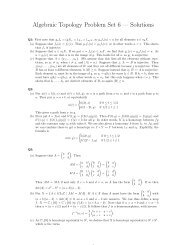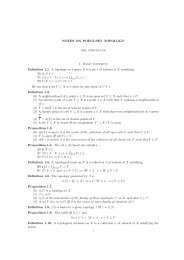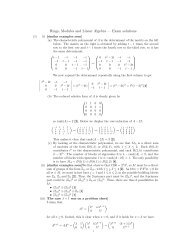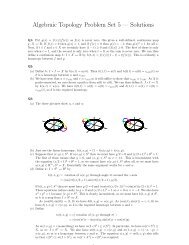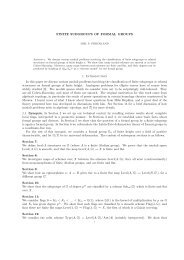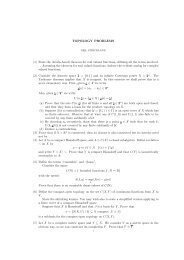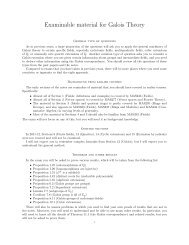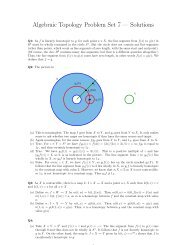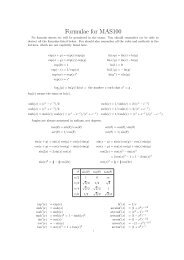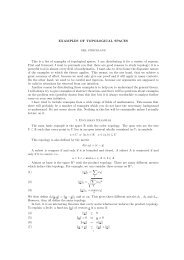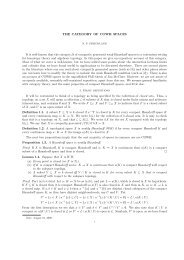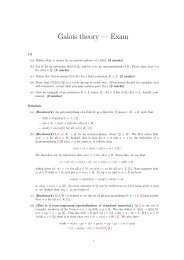A MATHEMATICA REPRESENTATION OF SOME ... - Neil Strickland
A MATHEMATICA REPRESENTATION OF SOME ... - Neil Strickland
A MATHEMATICA REPRESENTATION OF SOME ... - Neil Strickland
You also want an ePaper? Increase the reach of your titles
YUMPU automatically turns print PDFs into web optimized ePapers that Google loves.
2 N. P. STRICKLAND• I have used the following formula for the Hopf invariant of a composite: for α ∈ π n S mand β ∈ π m S i (with n > 1 and m, i > 0) we haveH(β ◦ α) = H(β) ◦ α + (Σ i−1 β) ◦ (Σ m−1 β) ◦ H(α)This is a special case of [1, Corollary III.6.3]. (Note that his γ 2 is our H, and his β#β isour (Σ i−1 β) ◦ (Σ m−1 β), whereas Toda’s β#β is β ∧ β = (Σ i β) ◦ (Σ m β).) It is apparentlywell-known to the experts that the proof in [1] is incorrect. However, the formula is knownto become true after one suspension, and it is also true for easy reasons if either α or βis a suspension. I do not know whether there are any cases in which the formula itself isincorrect.2.1. Abelian groups.2. Mathematica notation• The expression Group[{x 1 , d 1 }, . . . , {x r , d r }] represents an abelian group that is the directsum of cyclic groups of order d i generated by elements x i . The order d i may be Infinity.Expressions of this form are displayed (by default) in traditional notation, for exampleGroup[{x,Infinity},{y,24}] is displayed as Zx ⊕ Z 24 y. One can type FullForm[A] tosee the internal representation.• An isomorphism class of finitely generated abelian groups is represented by an expressionof the form GType[d 1 , . . . , d r ] with 1 < d 1 ≤ . . . ≤ d r ≤ ∞; this represents ⊕ i Z d i, whereZ ∞ just means Z.• If A is an expression of the form Group[. . . ], then GroupType[A] represents the isomorphismclass, GroupOrder[A] gives the order, GroupRank[A] gives the number of cyclic summands,Generators[A] gives the list of generators of these summands, GroupExponent[A] givesthe exponent, and Elements[A] gives the list of all elements of A (if A is finite). Theboolean function FiniteQ[A] is true iff A is a finite group.• The function ElementQ[a,A] will return True if a is visibly an integral linear combinationof the generators of A.• The expression Coset[a, {x 1 , . . . , x r }] refers to the coset of a modulo the subgroup generatedby the elements x i .2.2. Spaces.• The expression Sphere[n] represents the sphere S n , which we officially define to be theone-point compactification of R n . There is no real sign issue in identifying this withI n /∂(I n ), or in identifying S n ∧ S m with S n+m . There are sign issues in identifying S nwith ∆ n /∂(∆ n ) or with the space Sround n := {x ∈ Rn+1 | ‖x‖ = 1}.• We define ΣX = X ∧ S 1 . This is represented in Mathematica as Sigma[X]; the 4-foldsuspension of X (for example) can then be entered as SigmaIterate[4,X], but it will berepresented internally as Sigma[Sigma[Sigma[Sigma[X]]]].• The expression OrthogonalGroup[n] represents the orthogonal group O n .2.3. Homotopy sets.• The expression HomotopySet[X,Y] represents the set of homotopy classes of based mapsfrom X to Y . This will generally have at most one reasonable group structure. At presentwe have no support for nonabelian groups, and no support for multiple group structures.• The expression HomotopyGroup[n,X] refers to π n X. It is automatically converted toHomotopySet[Sphere[n],X].• The expression SpherePi[n,m] refers to Toda’s πn m , which is a naturally defined subgroupof π n S m such that π n S m = πn m ⊕ (odd torsion). We will probably redefine it later to referto π n S m itself. There is ambiguity about this in the code at the moment.• The expression OrthogonalPi[n,m] refers to π n O m .• Given an element a ∈ [X, Y ], we have Source[a]=X and Target[a]=Y. If X = S n wehave SourceSphere[a]=n. Similarly, if Y = S m we have TargetSphere[a]=m. If X = S n



